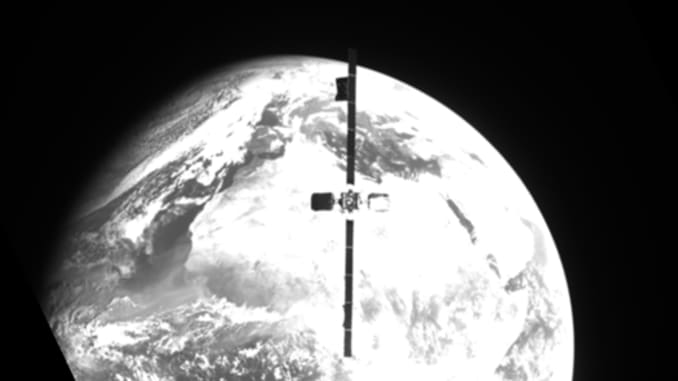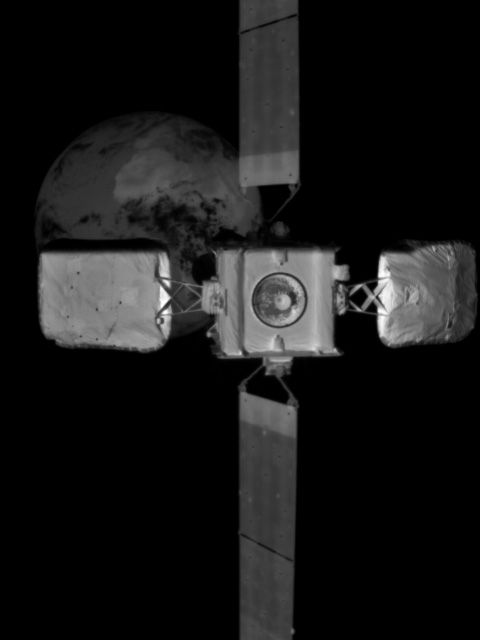A Northrop Grumman robot successfully docked to a satellite to extend its life
Satellites could live longer lives thanks to new technology being tested by Northrop Grumman.
On Monday (April 12), Northrop Grumman Corporation and SpaceLogistics LLC (a subsidiary of Northrop Grumman) announced that their satellite servicing spacecraft, called Mission Extension Vehicle 2 (MEV-2), successfully docked to the commercial communications satellite Intelsat 10-02 (IS-10-02).
MEV-2 is a robotic spacecraft designed to attach itself to aging satellites to help extend their operations in orbit. It launched Aug. 15, 2020, on an Ariane 5 rocket. MEV-2 follows in the footsteps of its predecessor MEV-1, which connected to a different Intelsat satellite Feb. 25, 2020.
Video: Northrop Grumman's MEV-2 docks with satellite
Related: The most historic satellites ever launched

The docking of MEV-2 to this Intelsat satellite Monday "was every bit as exciting and successful as the docking of MEV-1," Joe Anderson, the director of Mission Extension Vehicle services at Northrop Grumman, said during a live webinar Monday.
The craft began docking at around 6:30 a.m. EDT (1030 GMT) and was completely at 1:34 p.m. EDT (1734 GMT), according to Anderson.
In a newly released image, you can actually see IS-10-02 from the perspective of MEV-2 coming in to dock; the vehicle's infrared, wide field of view camera was able to image the satellite from 49 feet (15 meters) away. "This is the first time humans have seen this satellite since it launched in June of 2004," Anderson added.
Get the Space.com Newsletter
Breaking space news, the latest updates on rocket launches, skywatching events and more!

With MEV-1, the team behind the spacecraft had the servicing spacecraft dock with the Intelsat 901 (IS-901) communications satellite in what Anderson described as "the geo graveyard orbit," which is about 186 miles (300 kilometers) above geosynchronous orbit, which is 22,236 miles (35,786 kilometers) above Earth's equator, before moving the pair into the orbit where they would operate. They did this "out of a self-imposed abundance of caution," as this mission was the first of its kind for the company, Anderson said. But following the success of that mission, they were able to dock MEV-2 directly in geosynchronous orbit where it will operate.
"With the docking of MEV-1 last February, we made history; we created an entirely new market in orbit," Tom Wilson, vice president of strategic space systems at Northrop Grumman and president of SpaceLogistics, LLC said during the webinar. "We are now the only provider of life extension services for satellites, operating not just one but two mission extension vehicles ... with these capabilities, we can enable entirely new classes of missions."
Northrop Grumman's MEVs are the company's first line of robotic satellite-servicing spacecraft, but they are just the tip of the iceberg for what it has planned, Anderson said today.
For MEV-2, the spacecraft will stay in orbit attached to IS-10-02 for five years, helping to keep it "alive," and functioning in orbit. At the end of this five-year contract, the craft will be available to jet off to another satellite and dock. Both MEV-1 and MEV-2 are capable of working with multiple satellites in their lifetimes, Anderson said.
In 2024, however, Northrop Grumman will take things a step further by launching Mission Extension Pods (MEPs), which the company is developing currently. MEPs will also provide life extension services to satellites — Northrop Grumman plans to install these pods on both commercial and government satellites using its Mission Robotic Vehicle (MRV), which is being developed to repair, change, assemble and inspect satellites in orbit.
These upgrades and new technologies come from a robotic servicing mission award awarded last year to Grumman by DARPA (the Defense Advanced Research Projects Agency).
Going forward, Northrop Grumman projects that starting in 2025 they will begin refueling satellites in orbit and removing orbital debris from nearby "high value" satellites, Anderson said.
Northrop Grumman is considering removing debris, or "space junk," from orbit (at least nearby satellites and "high-value assets"), using the MRV's robotic arms.
Related: Orbit Fab demonstrates satellite refueling tech on space station
"Right now, we're focusing on exploring how we can use the capabilities that the mission robotic vehicle will provide with its robotic arm capabilities, perhaps some new tools that we might incorporate onto the end of that robotic arm to be able to rendezvous with and then capture a body that needs removal from GEO [geosynchronous] orbit," Anderson told Space.com during the webinar.
Anderson added that, starting in 2030, the company plans to begin assembling and manufacturing technology in-orbit. They hope that this will allow them to overcome "the burdens on spacecraft design that rocket launches impose, resulting in new and exciting possibilities in space," he said.
"If you design a satellite that was manufactured in orbit ... we estimate that maybe 80% of the mass of a satellite being launched is there to support the launch loads," or the payload launched to space, Anderson told Space.com "so that's a significant component to how spacecraft are designed today … So if we can design satellites that are manufactured, assembled in orbit, can completely change the economics of those assets."
Following the success of these life-extending spacecraft, this ultimate stage of being able to assemble and manufacture in space is "where the real change comes," Wilson added.
Email Chelsea Gohd at cgohd@space.com or follow her on Twitter @chelsea_gohd. Follow us on Twitter @Spacedotcom and on Facebook.
Join our Space Forums to keep talking space on the latest missions, night sky and more! And if you have a news tip, correction or comment, let us know at: community@space.com.

Chelsea “Foxanne” Gohd joined Space.com in 2018 and is now a Senior Writer, writing about everything from climate change to planetary science and human spaceflight in both articles and on-camera in videos. With a degree in Public Health and biological sciences, Chelsea has written and worked for institutions including the American Museum of Natural History, Scientific American, Discover Magazine Blog, Astronomy Magazine and Live Science. When not writing, editing or filming something space-y, Chelsea "Foxanne" Gohd is writing music and performing as Foxanne, even launching a song to space in 2021 with Inspiration4. You can follow her on Twitter @chelsea_gohd and @foxannemusic.









